- Author Jason Gerald [email protected].
- Public 2023-12-16 10:50.
- Last modified 2025-01-23 12:04.
Goals and achievements can bring about change in this life by making certain things better. Just as when athletes experience "running euphoria" after a match, so does the feeling of joy and pride that a person experiences for achieving a goal. However, the goal cannot be realized by itself. You must try to succeed in achieving it. This article will discuss various ways of setting and achieving goals. Live your life with purpose and keep trying to achieve all your dreams.
Step
Part 1 of 3: Setting Goals
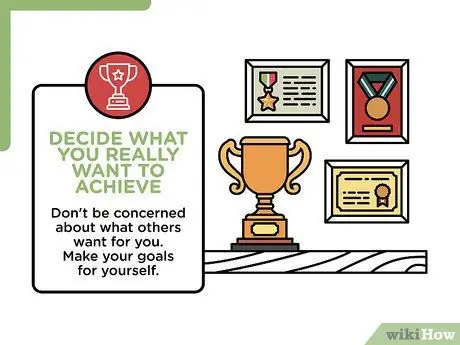
Step 1. Decide what you really want to achieve
Set goals for yourself and don't worry about what other people want for you. Some studies show that someone who has a goal that is useful for his personal life, will try harder to achieve it.
- Often, this is the most difficult part of the process of setting goals and achieving them. What do you want? The answer to this question is usually a combination of intrinsic and extrinsic motivation. Frequently buzzed phrases such as “keep being who you really are” often clash with family and work interests. Find a goal that can create balance in your life, one that makes you happy and benefits the people you love and others whose lives depend on you.
- Ask yourself the following questions, for example “What do I want to give to my family/my community/my life?” or “How can I improve even more?” These questions can help you set goals.
- It's okay if you have too many ideas right now. You can select it later.
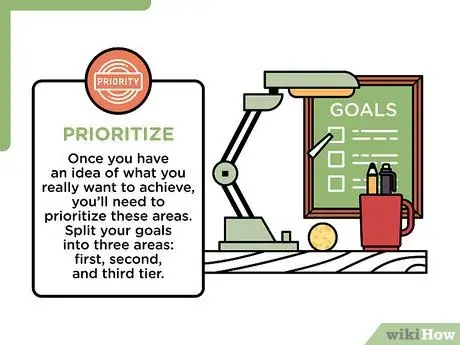
Step 2. Set priorities
Once you have an idea of what you really want to achieve, prioritize the aspects of your life that relate to this idea. If you want to develop every aspect of life at the same time, you will only be overwhelmed and unable to achieve any goals.
- Divide your goal into three levels: first, second, and third. First-level goals are the goals that are most important to you and are usually easier to define. Level two and three goals are goals that are less important and more limited or specific in nature.
- For example, your first-level goal might be “improve my health” or “make more time for my family”. A level two goal might be “keep my room clean, learn to surf” and a level three goal might be “learn to knit, wash clothes more regularly”.
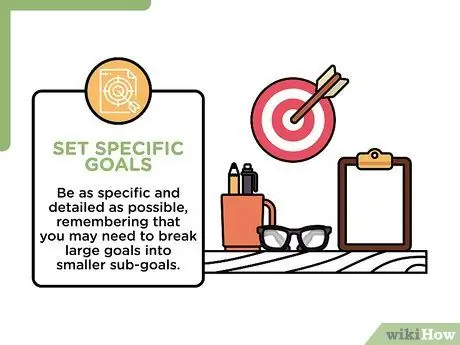
Step 3. Define specific goals
Be specific and realistic about what you want to achieve. Research has shown that setting specific goals makes you more likely to achieve them and can even make you feel happier. Keeping in mind that you'll have to break down your big goals into smaller ones, be specific and realistic about your main goals from the start.
- Ask yourself questions about your goals. What must you do to achieve your goals? Who can help you? When should each stage of your goal have been achieved?
- For example, the goal of “Being healthier” is too big and vague to be considered a good goal formulation. “Eat a healthy diet and exercise more” would be better, but this formulation is not detailed enough or still lacks specificity.
- “Eat 3 plates of fruits and vegetables every day and exercise 3 times a week” is a specific and concrete goal that makes it easier to achieve.
- In order to achieve these goals, you must also determine how to do them. For example, to achieve your goal of eating fruits and vegetables, do you also bring healthy snacks to work? Prefer a plate of fruit over fries the next time you eat out? To reach your goals by exercising, will you work out at the gym or walk in your neighborhood? Think about what actions you need to take to “support” your main goal.
- If your goal is gradual, when should you complete each stage? For example, if you want to train for a marathon, you need to know how long you need to train at each stage.
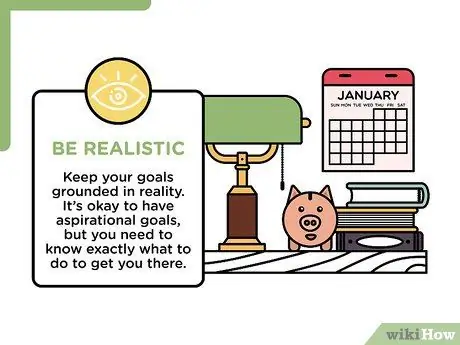
Step 4. Set realistic goals
Your most concrete and specific goal will never be achieved if what you want is “to buy a 3-bedroom apartment in the Menteng area in Jakarta” while your ability is more suited to “buy a studio apartment in the Dramaga area in Bogor”. Match your goals with the reality. You may have high goals, but you have to know exactly what you need to do in order to achieve them.
For example, if your main goal is to buy a big house in a big city, you will need to develop several supporting plans to make this goal a reality. Maybe you should save money, improve your credibility, maybe even increase your income. Write down all of these supporting plans along with the steps to be taken for each

Step 5. Write down all your goals
Write down your goals in detail and clearly by setting a time limit. Goals that are written will feel more real. Find the right place for these written goals to be easily visible to keep you motivated.
Write your goals in positive words. You will be more motivated if your goals are formulated in positive sentences such as “Eat more fruits and vegetables” instead of “No more eating unhealthy foods”
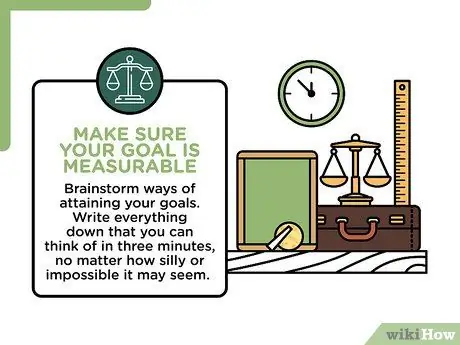
Step 6. Set measurable goals
How do you know that your goal has been achieved? If your goal is to move to a new house, you can know the achievement of this goal based on the schedule for signing the lease agreement or deed of sale and purchase agreement for your new home. But there are also goals that cannot be directly measured. If your goal is to become a better singer, how will you know that you have achieved your goal? Try to set measurable goals.
- For example, you can memorize and sing a song “perfectly”. Play a musical instrument while singing. Strive for higher notes. Measurable goals will create a feeling of accomplishment when you can do them so that you can achieve bigger goals.
- Look for inspiration on how to achieve your goals. Is there another way to achieve your goal? Write down whatever comes to mind in three minutes, even if it sounds stupid or makes no sense. If your goal is to lose weight, the ways you can choose are joining the gym, changing your diet, adjusting your daily schedule to include walking activities, commuting to and from work by bicycle, preparing your own meals regularly instead of buying food. fast food, or use the stairs instead of the elevator. There are many routes to the same destination. Make your destination the final destination and determine which route or routes will you choose?

Step 7. Set goals that match your abilities
Remember that you can only control your own actions, not the actions of others. “Being a rock star” is not a reliable goal because you have to involve the actions and responses of others over which you have no control. But “form a band and train to become great musicians” is a goal you can achieve through your own efforts.
- Focusing on your own actions will be very helpful if you have to experience failure because you know how prepared you are to face any obstacles that may come your way.
- Remember that goals can also be processes. For example, “becoming a senator” is highly dependent on the actions of others over which you have no control. If you don't make it to the senator, you may feel like you're failing your goals even if you've done your best. But "to occupy a position in government" is a goal that you can achieve, even if you don't win the election, because you have gone through the process well.
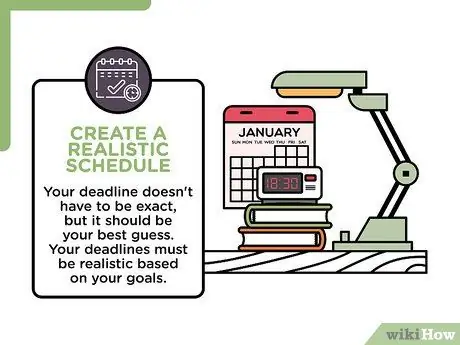
Step 8. Set a realistic schedule
You don't need to set exact deadlines, but you do need to be able to estimate accurately. Set realistic deadlines based on your goals. If you work part time with minimal wages, don't set a goal to make billions of rupiah at the end of the year. Give yourself enough time so that you can achieve what you have planned.
- Set a deadline. We all like to procrastinate. This trait seems very human, but if you have to face a deadline, you will work hard to prepare yourself. Imagine you are in school. If you have to take a test, you know you have to study and you do it. Set goals for yourself so that you can spur you to achieve them in the same way.
- Remember that some goals can take longer to achieve than others. “Eat more fruits and vegetables” can be achieved in no time. “Having a fitter body” takes more time and effort. Set a schedule for achieving your goals well.
- Consider external deadlines and schedules. For example, if your goal is “Find a new job”, you should consider the time it takes for potential employers to process your application.
- Prepare gifts. Humans will respond well to appreciation. Whenever you achieve some of your goals, give yourself a small reward no matter how little progress you make. For example, if your goal is to practice playing music more regularly, give yourself half an hour to read a comic book or watch your favorite TV show after you finish your daily workout.
- Don't punish yourself if you don't achieve your goals. Punishing or blaming yourself for not getting things done can really get in the way of your success.
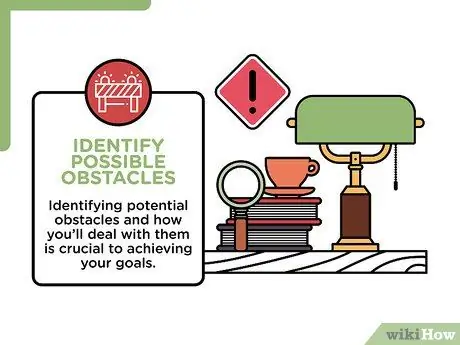
Step 9. Find out if there are any obstacles
No one wants to think about failure when they are planning for success. However, figuring out potential problems and how you can deal with them is critical to achieving your goals. Otherwise, you are not prepared if an obstacle suddenly appears.
- Obstacles can come from outside. For example, if your goal is to open a new car shop, you may not initially have enough money to buy a shop. If your goal is to open a bakery, you may not be able to provide enough time for your family anymore.
- Determine actions you can take to overcome these potential obstacles. For example, you can apply for a business loan, prepare a business plan to attract investors, or invite a friend to set up a business together.
- Obstacles can also come from within. For example, lack of information can be a barrier, especially for more complex goals. Internal obstacles can come from emotions such as fear and uncertainty.
- Actions you can take to address the lack of information include reading more, seeking advice from a mentor, practicing, or taking courses.
- Know your limitations. For example, if the hurdle you're facing is not having enough time to focus on getting your business ready and providing the quality time you want with your family, maybe there really isn't a way to solve this problem. However, you can discuss this with your family by explaining that this situation is only temporary.
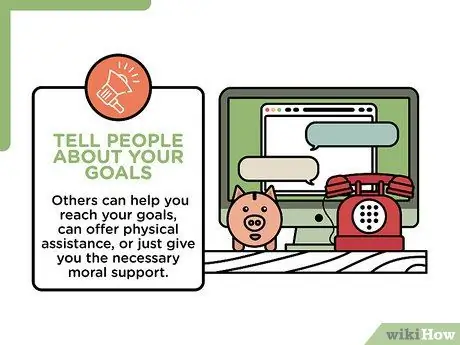
Step 10. Explain your goals to others
Some people feel ashamed to tell others their purpose in life. They are afraid to feel embarrassed if it turns out to be a failure. Don't think like this, but think that you are ready to face criticism that allows you to connect with others and become a more developed person. Other people can help you reach your goals, provide physical assistance, or simply provide the moral support you need.
- Others may not respond to your goals with the enthusiasm you expect. What is important to you may not be important to others. Try to recognize the difference between constructive feedback and negative comments. Listen to what they have to say, but furthermore, you will have to decide for yourself how important your goals are to yourself.
- You may meet people who do not support your goals. Remember that you are setting goals for yourself, not for others. If you constantly run into people who are negative about your goals, show that you don't like being judged or challenged. Ask this person to stop judging you.

Step 11. Find a community whose members share the same mindset
There may be other people whose goals are the same as yours. Try to find them so they can support each other by sharing knowledge and experiences. In addition, there will be someone who can celebrate success together if you succeed in achieving your goals.
Search online, take advantage of social media, and visit nearby places that can support your goals. In today's digital era, there are many ways to connect, stay connected, and form community
Part 2 of 3: Realizing the Goal
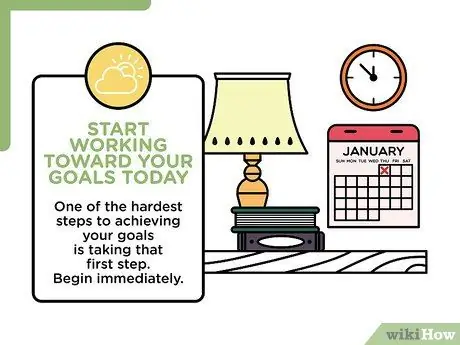
Step 1. Start realizing your goals today
The most difficult step in achieving the goal is the first step. Just start, even if you don't know exactly what to do. Listen to your heart and do something that can support your goals. When you've completed this step, know that you're on your way. You will continue to work towards your goals if you can immediately feel progress.
- For example, if your goal is “Eat healthy food”, go grocery shopping with fresh fruit and vegetables. Clean your kitchen of unhealthy food. Look for healthy food recipes online. These small actions are easy to perform, but provide quick results.
- If you want to learn a new skill, you have to start practicing. Strum the guitar and learn basic chords if you want to be a great musician. Start reading self-improvement books that can help beginners develop their new skills. Whatever your goal, there's always a quick way to get started.
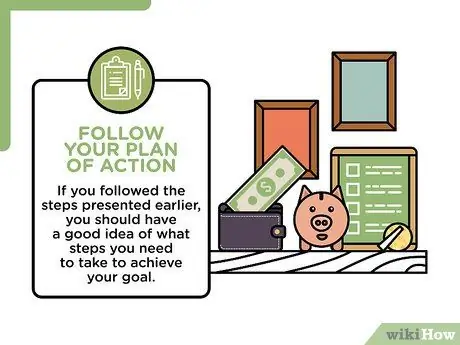
Step 2. Execute your action plan
If you understand the steps described above, you should have the right idea about the next steps you need to take to achieve your goal. This is the time to put all these ideas into practice.
For example, if your goal is to buy a three-bedroom house, go to a real estate website and find a home that fits (or is close to) your criteria. Determine your budget and how much down payment is required. Open a savings account for a down payment and start saving. Pay credit card bills on time and properly manage your credit facilities so that your credit rating is good

Step 3. Visualize achieving your goals
Research shows that visualization can improve your performance. There are two forms of visualization: result visualization and process visualization. Combine the two to achieve your goals.
- For the visualization of results, imagine yourself having succeeded in achieving your goals. Make this visualization as concrete and detailed as possible. How does it feel? Who was there to congratulate you? Do you feel proud? Happy?
- For process visualization, imagine the steps you must take to achieve your goal. For example, if your goal is to become a small business owner, imagine every action you must take to achieve this goal. Imagine that you are drafting a business plan, applying for a small business loan, seeking investors, etc.
- Process visualization can help your brain "code prospective memories." Psychologists say that this process will make you feel like you can achieve your goals because your brain has already experienced some of the success of this process.

Step 4. Take notes
Review your goals by reading them at least once a day. Read your goals every morning and before going to bed at night. Reflect on what you have done throughout the day to achieve your goals.
If there are goals on the list that have been achieved, don't cross them right away. Instead, create a new list with the title “obtained goals”. Sometimes, we just focus on what has not been achieved and forget about all the goals that have been achieved. Always carry this list of achievements with you so that it can be a source of motivation

Step 5. Ask for guidance
Find a mentor or someone who has already achieved similar goals and ask for their advice. Successful people can give you insight into what they've done or what you need to avoid in order to be successful. Listen carefully to their advice and learn from them regularly.
Just like in school, you don't have to teach yourself difficult math. It's much easier if you have a teacher--someone who already understands the "formula" of success-who is always ready to help you, explain how to solve problems, and celebrate your successes. A good mentor will feel just as proud as you if you achieve your goals
Part 3 of 3: Overcoming Problems in Achieving Goals

Step 1. Recognize “false hope syndrome”
You've probably experienced the syndrome of false hope if you've ever made a New Year's resolution. Psychologists explain that this syndrome consists of three parts that form a cycle: 1) setting goals, 2) feeling surprised at the face of adversity, 3) giving up.
- The pseudo-expectation syndrome often occurs when you expect immediate results from your efforts. For example, maybe you've set a goal of “Being a fitter body” and then get discouraged after you've been exercising for two weeks without feeling any results. Setting milestones and timelines will help you overcome unrealistic expectations.
- This syndrome can also occur when the initial "spirit" fades. For example, the goal of wanting to “Learn to play the guitar” will be fun at first, since you just bought a guitar, learned a few chords, etc. But by the time you have to practice every day, your fingers are calloused, and your chord learning progress stops, you'll lose your momentum. Having small goals and a habit of celebrating success will keep this momentum going.

Step 2. View challenges as learning experiences
Several studies have shown that people who use failure as a learning experience tend to feel more positive about their ability to achieve their goals. If you see your challenges, setbacks, or even mistakes as “failures” and blame yourself for them, you will focus on the past instead of expecting what you will achieve in the future.
- Research shows that people who achieve their goals usually don't experience fewer setbacks than people who give up easily. The difference lies in the way you view what is known as a setback. Can you learn from what went wrong so you can do something different next time?
- Demands to always be perfect can also prevent you from admitting mistakes as a means of growth. When you maintain a standard of performance that is impossible for you to achieve, you are actually developing the feeling that you will never reach your goal.
- Instead, become a person who is able to love yourself. Remind yourself that you are an ordinary person who cannot escape mistakes and must face challenges.
- Research shows that positive thinking is very effective in helping people learn and adjust rather than focusing on your mistakes or shortcomings. The next time you find yourself blaming yourself for what you perceive to be a failure, remember that you can learn from every experience, even if it felt very unpleasant at the time.

Step 3. Acknowledge every victory
Often the achievement of goals depends on perception. Celebrate every little victory. If your goal is to get an A and you make it, celebrate. If your goal is to become a lawyer, celebrate every step you make, such as getting accepted into law school, doing well in college, passing the bar exam, and finally getting a job.
- Celebrate achieving a standard of success or time target. There are certain goals that can only be achieved after a few years. Appreciate and celebrate the time you have spent doing something. Practice will take time and effort. Appreciate and be proud of the time you have given to certain things.
- Celebrate even the smallest accomplishments. For example, if your goal is “Eat healthy food” and you can say “no thanks” if offered a fatty but delicious pizza slice, give yourself a pat on the back for your persistence.

Step 4. Stay motivated
Whatever your goal, make it an excuse because this is what you want for yourself in the future. Show your passion and intent. By constantly reminding yourself of what you are struggling with, you will be able to get through difficult or unpleasant times. Sometimes, the best destinations force you through the most difficult journeys.
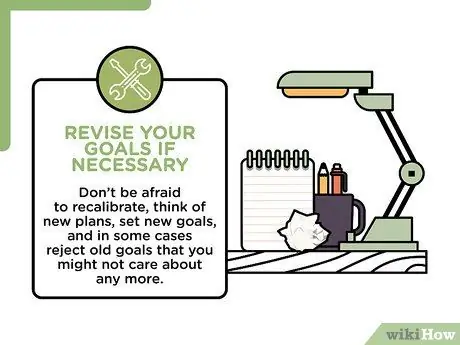
Step 5. Change your goals if necessary
In everyday life, there are always things we don't want. Sometimes, things happen that we don't expect and affect our plans. Don't be afraid to make adjustments, think of new plans, set new goals, and in some cases you may cancel old plans that you no longer need.
- Setbacks are natural and shouldn't hold you back from achieving your main goals. Find out why you are experiencing setbacks. Can you control this? Keep trying to achieve your goals as well as possible.
- Consider new opportunities. Many of the best things in life happen without a plan. Say yes to a new opportunity if it supports the achievement of your goals or can lead you to a new and better goal.

Step 6. Be a person who never gives up
Record every small success you have achieved. Successfully completing small tasks will build self-confidence because you feel capable of achieving what you have set. Think again of the success you've had if you faced a problem.
- Remember that setbacks don't mean failure. J. K. Rowling, the author of the Harry Potter novels, was rejected twelve times in a row before her manuscript was published. School teacher Thomas Edison, an inventor, once said that he was "too stupid to learn anything". Oprah was fired from her first job at a TV station and was given the nickname "not right for TV."
- Sometimes, negative feedback given by others can be a trigger for us to succeed in achieving our goals and dreams.






